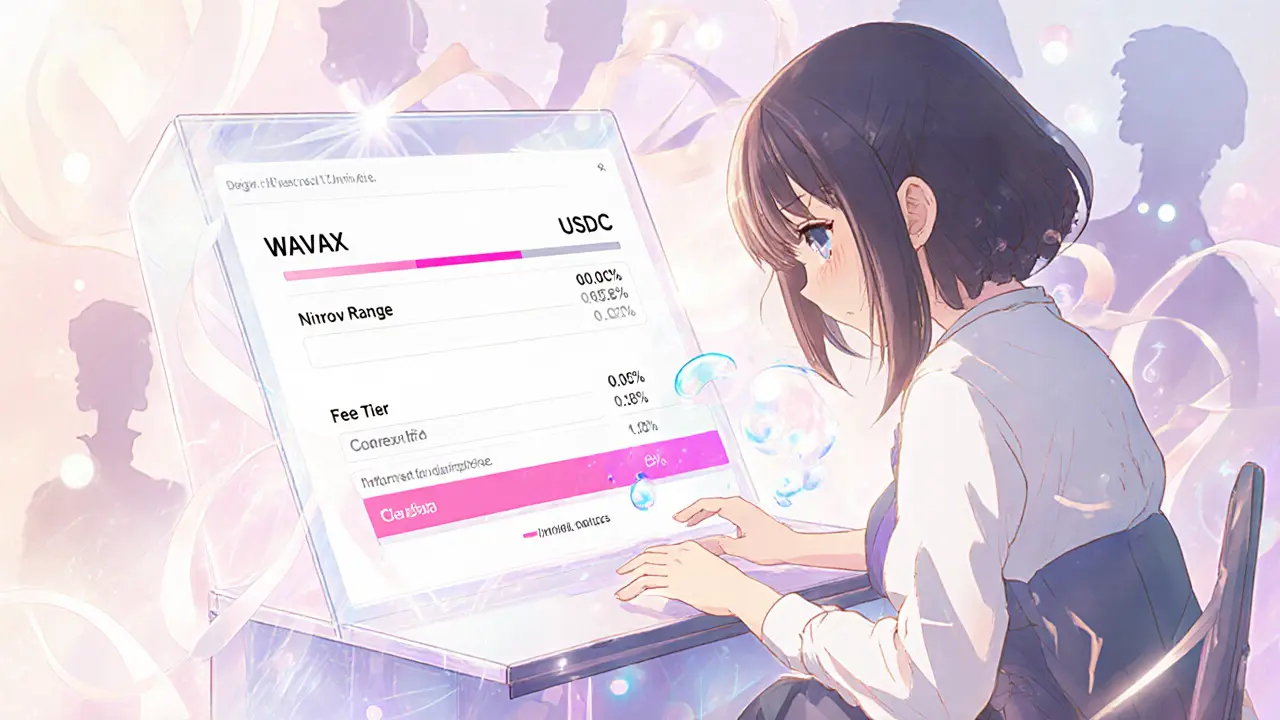Uniswap v3 (Avalanche) Fee Calculator
Potential Daily Earnings
About Uniswap v3 Fee Tiers
Uniswap v3 on Avalanche offers four fee tiers to optimize for different trading conditions:
- 0.01% - Best for ultra-stable pairs like USDC/USDT
- 0.05% - Ideal for stable coin or low-volatility pairs
- 0.3% - Standard fee for most trading pairs
- 1% - Higher fee for exotic or highly volatile pairs
Higher fees typically attract more traders but may reduce liquidity concentration. Lower fees are better for stable pairs with high volume.
Key Takeaways
- Uniswap v3 on Avalanche offers capital‑efficient concentrated liquidity and sub‑second transaction finality.
- Daily trading volume hovers around $10‑38million, with WAVAX/USDC accounting for >80% of activity.
- Fee tiers range from 0.01% to 1%, making it cheap for stable‑coin swaps but pricey for exotic pairs.
- Liquidity provision is powerful but steep; beginners should start with small ranges and the 0.05% fee tier.
- Compared with native Avalanche DEXs, Uniswap v3 trades slightly less volume but wins on capital efficiency and brand trust.
What is Uniswap v3 (Avalanche)?
Uniswap v3 (Avalanche) is a decentralized exchange (DEX) that runs on the Avalanche C‑chain, a high‑throughput blockchain that settles transactions in about 1.2 seconds. It brings Uniswap’s third‑generation Automated Market Maker (AMM) protocol to a layer‑1 network that was built to solve Ethereum’s gas‑fee bottleneck.
The platform launched in Q12023 as part of Uniswap Labs’ multi‑chain expansion. Unlike the original V2 model, V3 lets liquidity providers (LPs) allocate capital into narrow price bands-a feature called Concentrated Liquidity. This design can boost capital efficiency by up to 4,000× compared with the earlier version, according to Uniswap’s own whitepaper.
How does the AMM work on Avalanche?
When you initiate a swap, the protocol pulls the relevant token balances from your non‑custodial wallet (MetaMask, Trust Wallet, or Coinbase Wallet). The trade then interacts with a Liquidity Pool that holds the two assets you’re swapping. The price curve is determined by the ratio of tokens inside the pool and the fee tier you’ve selected.
Fee tiers are a crucial part of the experience:
- 0.01% - ultra‑stable pairs (e.g., USDC/USDT)
- 0.05% - stable‑coin or low‑volatility pairs
- 0.3% - most standard pairs
- 1% - exotic or highly volatile pairs
The fee you pay goes straight to the LPs who supplied liquidity in the selected price range, rewarding them for the risk they took.

Performance snapshot (October2025)
The latest CoinGecko data shows:
- 41 tokens listed across 63 trading pairs.
- 24‑hour volume between $10.1M and $37.5M (two reporting methods on the same platform).
- Average bid‑ask spread of 0.642%.
- WAVAX/USDC is the dominant pair, moving $30.6M daily - about 81.6% of total volume.
- Transaction confirmation averages 1.2seconds on Avalanche, versus 15+seconds on Ethereum.
In the broader DEX landscape, Uniswap v3 (Avalanche) sits in the 88th percentile for volume and 71st percentile for order‑book depth, according to CoinGecko’s trust scoring.
Step‑by‑step: Swapping tokens on Uniswap v3 (Avalanche)
- Install a supported wallet (MetaMask, Trust Wallet, Coinbase Wallet) and add the Avalanche network.
- Network ID: 43114
- RPC URL: https://api.avax.network/ext/bc/C/rpc
- Visit app.uniswap.org and click the chain selector. Choose “Avalanche.”
- Connect your wallet. The interface reads your token balances automatically.
- Select the token you want to sell (e.g., WAVAX) and the token you want to receive (e.g., USDC).
- Review the estimated price impact, slippage tolerance (default 0.5%), and fee tier.
- Confirm the transaction. Your wallet will prompt you to approve the gas fee (typically <$0.01 on Avalanche).
- Wait a few seconds for the transaction to settle. The receipt appears in your wallet and on the Uniswap interface.
For most first‑time users, the whole process takes about 2minutes.
Liquidity provision guide (the part that trips newbies)
Providing liquidity is where the capital‑efficiency gains live, but it also demands a solid grasp of price ranges, fee tiers, and impermanent loss. Here’s a simplified workflow:
- Navigate to the “Pool” tab and click “Create a new position.”
- Pick a token pair. For beginners, WAVAX/USDC on the 0.05% fee tier is a low‑risk entry.
- Set a price range. The interface shows a chart with the current market price; a tight band (e.g., ±2%) concentrates your capital.
- Tip: Start with a broader range if you’re unsure; you’ll earn less but stay active longer.
- Deposit the two tokens in the exact ratio required by the range.
- The UI automatically calculates how much of each token you need.
- Review the projected APR and the potential impermanent loss under different price scenarios.
- Confirm the transaction. Gas costs are negligible on Avalanche.
CryptoAdventure estimates that mastering this flow costs 5‑8hours of practice for seasoned DeFi users. Beginners should experiment with small amounts (e.g., $100‑$500) before scaling up.
How does Uniswap v3 (Avalanche) stack up against native Avalanche DEXs?
| Metric | Uniswap v3 (Avalanche) | TraderJoe | Pangolin |
|---|---|---|---|
| 24‑hour volume (Oct2025) | $10‑38M (est.) | $12M | $9M |
| Token count | 41 | ≈150 | ≈120 |
| Average slippage (≤$50k trade) | 0.06% (WAVAX/USDC) | 0.12% | 0.15% |
| Fee structure | 0.01 % - 1 % | 0.3 % | 0.25 % - 0.3 % |
| Capital‑efficiency tech | Concentrated liquidity (V3) | Standard V2 AMM | Standard V2 AMM |
The table shows that Uniswap v3 offers the best slippage on its core pair thanks to concentrated liquidity, but it lags behind in sheer token variety. Trader Joe compensates with a broader catalog, while Pangolin focuses on mid‑range fees.

Pros, Cons, and Who Should Use It
Pros
- Sub‑second settlement on Avalanche keeps costs low.
- Concentrated liquidity delivers up to 4,000× better capital efficiency.
- Multiple fee tiers let LPs tailor earnings to risk appetite.
- Strong brand trust - Uniswap’s core code enjoys 97% documentation coverage on GitHub.
Cons
- Liquidity provision UI is complex; steep learning curve for newcomers.
- Only 41 tokens listed, far fewer than Ethereum‑based Uniswap or native Avalanche competitors.
- Fee tier display is hidden during swaps, which can confuse casual traders.
- Regulatory gray area in the U.S.; the SEC treats DEXs as potential unregistered exchanges.
Best for experienced DeFi users who want low slippage on high‑volume stable pairs and are comfortable managing price ranges. Not ideal for absolute beginners or those looking for the widest token selection.
Regulatory outlook and future roadmap
The October2025 SEC guidance flags DEX protocols as possible securities exchanges if they facilitate trading of unregistered assets. Uniswap’s decentralized architecture makes enforcement tricky, but U.S. users might face stricter KYC requirements on bridge services.
Uniswap Labs is already planning Uniswap V4 for Q22026. V4 will add “hooks,” letting developers attach custom logic to swaps - think on‑chain limit orders or dynamic fee adjustments. If those hooks land on Avalanche, the platform could close the feature gap with native DEXs that already offer custom incentive programs.
Bottom line
Uniswap v3 (Avalanche) proves that a flagship Ethereum DEX can retain its core advantages - capital efficiency, low fees, and a trusted codebase - while shedding the network‑congestion pain points that plague Ethereum trades. The trade‑off is a narrower token roster and a UI that rewards patience.
If you value razor‑thin slippage on big stable‑coin swaps and don’t mind spending a few hours learning price‑range mechanics, the platform is a solid choice. Otherwise, native Avalanche DEXs like TraderJoe may feel simpler, even if they cost a bit more per trade.
Frequently Asked Questions
How do I add the Avalanche network to MetaMask?
Open MetaMask, click the network dropdown, choose “Add Network,” and fill in: Network Name = Avalanche C‑Chain, RPC URL = https://api.avax.network/ext/bc/C/rpc, Chain ID = 43114, Symbol = AVAX, Explorer URL = https://cchain.explorer.avax.network.
What fee tier should I pick for WAVAX/USDC?
WAVAX/USDC is a low‑volatility pair, so the 0.05% fee tier usually offers the best net return for liquidity providers. Traders will see a tiny fee, and LPs still capture a decent portion of the volume.
Is Uniswap v3 (Avalanche) safe to use?
The protocol is open‑source, audited multiple times, and runs on a permissionless blockchain. Your safety hinges on using a trusted wallet, keeping private keys offline, and double‑checking contract addresses when bridging assets.
Why does my transaction sometimes cost more gas on Avalanche?
During network congestion (e.g., a popular NFT drop), validators raise the base fee to prioritize bundles. Even so, Avalanche’s fees stay well under $0.02, far cheaper than Ethereum’s typical $5‑$20 fees.
Will Uniswap V4 be available on Avalanche?
Uniswap Labs plans a multi‑chain V4 rollout in Q22026. While the roadmap lists Ethereum first, the team has committed to bringing V4 to every chain that runs the V3 contracts, so Avalanche should see the upgrade later in 2026.


Melanie Birt
October 10, 2025 AT 09:20Uniswap v3 on Avalanche slashes transaction costs by leveraging the chain’s sub‑second finality, which means traders can swap with near‑zero fees. The four fee tiers let liquidity providers target the exact volatility profile of their pair, from ultra‑stable 0.01% to risky 1% pools. By concentrating liquidity around the current price, you also boost capital efficiency, so even modest deposits earn decent APRs. If you’re looking to diversify your DeFi yield, plugging a stable‑coin pair into the 0.05% tier is a solid start 😊.
Lady Celeste
October 16, 2025 AT 21:57Wow, another fee tier gimmick that nobody asked for.
Hanna Regehr
October 23, 2025 AT 10:35For anyone new to the Avalanche ecosystem, the speed advantage translates directly into lower slippage on high‑volume trades. Pairing that with Uniswap v3’s concentrated liquidity model means you can achieve the same returns with less capital. Remember to balance fee tier selection against the expected volatility of the asset pair. Keeping your liquidity in a tight range around the market price maximizes fee capture.
Ben Parker
October 29, 2025 AT 23:13Totally agree 🙌, the speed boost is a game‑changer. Just don’t forget to monitor the price range or you’ll end up earning dust.
Nathan Van Myall
November 5, 2025 AT 11:51The 0.01% tier is specifically designed for pairs like USDC/USDT where price deviation is minimal, so the fee revenue comes from sheer volume rather than spread.
Annie McCullough
November 12, 2025 AT 00:29Liquidity providers on Uniswap v3 must grapple with the concept of tick spacing which directly influences the granularity of price ranges. A narrower tick spacing yields higher capital efficiency but also increases the computational overhead for rebalancing. When operating on Avalanche, the underlying consensus mechanism reduces block propagation latency allowing more frequent re‑balancing without incurring prohibitive gas costs. However the protocol imposes a minimum liquidity amount per tick to prevent dust accumulation and protect the pool from micro‑liquidity attacks. Consequently, providers need to calibrate their position size relative to the chosen fee tier to avoid under‑collateralization. The 0.05% tier represents a sweet spot for mildly volatile assets where the trade‑off between fee capture and trader attraction is optimal. In contrast the 1% tier is a defensive posture against impermanent loss on highly volatile exotic pairs while still generating respectable yields for risk‑tolerant participants. The fee tier architecture also interacts with the pool’s fee growth global variables which track cumulative fees earned per unit of liquidity. By inspecting the feeGrowthInsideX variables one can derive the precise earnings attributable to a specific price band. Moreover the introduction of the “oracle” library on Avalanche provides deterministic price feeds that enhance the reliability of price range calculations. It’s crucial to align the oracle update frequency with the liquidity provision schedule to mitigate stale price exposure. Providers should also be aware of the gas‑optimised “swap” implementation that utilizes the AVAX‑C-Chain’s native token for fee settlement, reducing the need for separate token approvals. The interplay between gas costs and fee tier selection ultimately determines net APR, especially for smaller liquidity providers. Finally, regular audit of pool performance metrics such as TVL, fee tier utilization, and tick occupancy will inform strategic adjustments and safeguard against suboptimal capital deployment.
Carol Fisher
November 18, 2025 AT 13:07Sounds like a textbook lecture – but yeah, the math checks out. Still, most retail folks just pick the 0.3% pool and hope for the best 🙄.
Daron Stenvold
November 25, 2025 AT 01:45Let’s not discount the power of concentrated liquidity – even a modest amount in a tight range can out‑perform a sprawling position in a 0.3% pool, especially on a high‑throughput chain like Avalanche.